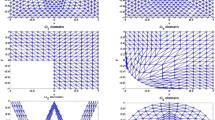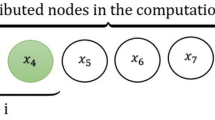Abstract
The Rayleigh–Stokes problem for a heated generalized second grade fluid with fractional derivatives, plays a significant role in describing the dynamic behaviour of some non-Newtonian fluids.The presence of the time-fractional derivative in the equation is to capture the viscoelastic behaviour of the flow. In the current paper, we propose a high order numerical method to solve the two dimensional case of mentioned equation on regular and irregular regions. To this end, we use an unconditionally stable scheme of order \(\mathcal {O}(\tau ^{2})\) to discretize this problem in temporal direction. Afterwards, using a high order method to discretize this problem in space directions, fully discrete scheme is achieved. Error estimate of fully discrete scheme is given. Using numerical simulation, we investigate the accuracy of the proposed scheme on regular and irregular domains, including convex and non-convex domains. Also, the numerical results are compared with the results of other methods in literature to show the accuracy and efficiency of the proposed method.











Similar content being viewed by others
References
Bandelli R, Rajagopal K (1995) Start-up fows of second grade fluids in domains with one finite dimension. Int J Non Linear Mech 30:817–839
Belgacem FB, Bernardi C (1999) Spectral element discretization of the Maxwell equations. Math Comput 68:1497–1520
Canuto C, Hussaini MY, Quarteroni A, Zang TA (2006) Spectral methods: fundamentals in single domains. Springer, Berlin
Chakraborty A, Sivakumar MS, Gopalakrishnan S (2006) Spectral element based model for wave propagation analysis in multi-wall carbon nanotubes. Int J Solids Struct 43:279–294
Chen CM, Liu F, Anh V (2008) Numerical analysis of the Rayleigh-Stokes problem for a heated generalized second grade fluid with fractional derivatives. Appl Math Comput 204:340–351
Dehghan M, Abbaszadeh M (2017) A finite element method for the numerical solution of Rayleigh–Stokes problem for a heated generalized second grade fluid with fractional derivatives. Eng Comput 33:587–605
Dehghan M, Sabouri M (2013) A Legendre spectral element method on a large spatial domain to solve the predator-prey system modeling interacting populations. Appl Math Model 37:1028–1038
Dehghan M, Shafieeabyaneh N, Abbaszadeh M (2021) Numerical and theoretical discussions for solving nonlinear generalized Benjamin-Bona-Mahony-Burgers equation based on the Legendre spectral element method. Numer Methods Partial Differ Equ 37:360–382
Fetecau C, Zierep J (2001) On a class of exact solutions of the equations of motion of a second grade fluid. Acta Mech 150:135–138
Giraldo FX (2003) Strong and weak Lagrange-Galerkin spectral element methods for the shallow water equations. Comput Math Appl 45:97–121
Gordon WJ, Hall CA (1973) Construction of curvilinear co-ordinate systems and applications to mesh generation. Int J Numer Methods Eng 7:461–477
Gordon WJ, Hall CA (1973) Transfinite element methods: blending-function interpolation over arbitrary curved element domains. Numer Math 21:109–129
Hesthaven JS, Gottlieb S, Gottlieb D (2007) Spectral methods for time-dependent problems. Cambridge University Press, Cambridge
Karniadakis GE, Sherwin SJ (2004) Spectral/HP element methods for CFD, 2nd edn. Oxford University Press, Oxford
Khan MA, Ali NHM, Hamid NNA (2020) A new fourth-order explicit group method in the solution of two-dimensional fractional Rayleigh-Stokes problem for a heated generalized second-grade, fluid. Adv Differ Equ 598:1–22
Khan MA, Ali NHM (2020) High-order compact scheme for the two-dimensional fractional Rayleigh–Stokes problem for a heated generalized second-grade fluid. Adv Differ Equ 233:1–21
Kharazmi E, Zayernouri M, Karniadakis GE (2017) A Petrov-Galerkin spectral element method for fractional elliptic problems. Comput Methods Appl Mech Eng 324:512–536
Kopriva DA (2009) Implementing spectral methods for partial differential equations. Springer, Berlin
Korczak KZ, Patera AT (1986) An isoparametric spectral element method for solution of the Navier-Stokes equations in complex geometry. J Comput Phys 62:361–382
Mehdizadeh OZ, Paraschivoiu M (2003) Investigation of a two-dimensional spectral element method for Helmholtz’s equation. J Comput Phys 189:111–129
Mohebbi A, Abbaszadeh M, Dehghan M (2013) Compact finite difference scheme and RBF meshless approach for solving 2D Rayleigh–Stokes problem for a heated generalized second grade fluid with fractional derivatives. Comput Methods Appl Mech Eng 264:163–177
Nikan O, Golbabai A, Tenreiro Machado JA, Nikazad T (2020) Numerical solution of the fractional Rayleigh-Stokes model arising in a heated generalized second-grade fluid. Eng Comput. https://doi.org/10.1007/s00366-019-00913-y
Nikan O, Avazzadeh Z (2021) An improved localized radial basis-pseudospectral method for solving fractional reaction-subdiffusion problem. Results Phys 23:104–148
Nikan O, Tenreiro Machado JK, Golbabai A, Rashidinia J (2021) Numerical evaluation of the fractional Klein-Kramers model arising in molecular dynamics. J Comput Phys 32:45–60
Nikan O, Avazzadeh Z, Tenreiro Machado JA (2021) A local stabilized approach for approximating the modified time-fractional diffusion problem arising in heat and mass transfer. J Adv Res 32:45–60
Patera AT (1984) A Spectral element method for fluid dynamics: laminar flow in a channel expansion. J Comput Phys 54:468–488
Pozrikidis C (2005) Introduction to finite and spectral element methods using Matlab. Chapman and Hall, London
Quarteroni A, Valli A (2008) Numerical approximation of partial differential equations. Springer, Berlin
Rajagopal K (1982) A note on unsteady unidirectional flows of a non-Newtonian fluid. Int J Non Linear Mech 17:369–373
Safari F, Sun H (2020) Improved singular boundary method and dual reciprocity method for fractional derivative Rayleigh-Stokes problem. Eng Comput. https://doi.org/10.1007/s00366-020-00991-3
Shivanian E, Jafarabadi A (2018) Rayleigh-Stokes problem for a heated generalized second grade fluid with fractional derivatives: a stable scheme based on spectral meshless radial point interpolation. Eng Comput 34:77–90
Sherwin SJ, Karniadakis GE (1995) A triangular spectral element method: applications to the incompressible Navier-Stokes equations. Comput Methods Appl Mech Eng 123:189–229
Shen F, Tan W, Zhao Y, Masuoka T (2006) The Rayleigh-Stokes problem for a heated generalized second grade fluid with fractional derivative model. Nonlinear Anal Real World Appl 7:1072–1080
Tan W, Masuoka T (2005) Stokes first problem for a second grade fluid in a porous half-space with heated boundary. Int J Non Linear Mech 40:515–522
Tian WY, Zhou H, Deng WH (2015) A class of second order difference approximations for solving space fractional diffusion equations. Math Comput 84:1703–1727
Wang Z, Vong S (2014) Compact difference schemes for the modified anomalous fractional sub-diffusion equation and the fractional diffusion-wave equation. J Comput Phys 277:1–15
Yu Q, Song J, Liu F, Anh V, Turner I (2009) An approximate solution for the Rayleigh-Stokes problem for a heated generalized second grade fluid with fractional derivative model using the Adomian decomposition method. J Algorithm Comput Technol 3:553–571
Zhuang PH, Liu QX (2009) Numerical method of Rayleigh-Stokes problem for heated generalized second grade fluid with fractional derivative. Appl Math Mech 30:1533–1546
Zhuang Q, Chen L (2017) Legendre-Galerkin spectral-element method for the biharmonic equations and its applications. Comput Math Appl 74:2958–2968
Zierep J, Fetecau C (2007) Energetic balance for the Rayleigh-Stokes problem of a Maxwell fluid. Int J Eng Sci 45:617–627
Author information
Authors and Affiliations
Corresponding author
Additional information
Publisher's Note
Springer Nature remains neutral with regard to jurisdictional claims in published maps and institutional affiliations.
Rights and permissions
About this article
Cite this article
Saffarian, M., Mohebbi, A. High order numerical method for the simulation of Rayleigh–Stokes problem for a heated generalized second grade fluid with fractional derivative on regular and irregular domains. Engineering with Computers 39, 2851–2868 (2023). https://doi.org/10.1007/s00366-022-01647-0
Received:
Accepted:
Published:
Issue Date:
DOI: https://doi.org/10.1007/s00366-022-01647-0




